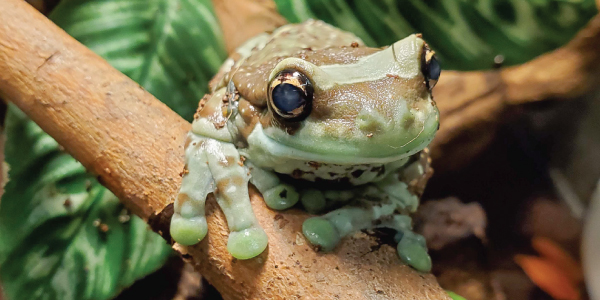
| You can meet at the Racine Zoo: |
Three individuals, sex and date of birth unknown
|
| Location at the Racine Zoo: | In the Discovery Center |
| Scientific Name: |
Trachycephalus resinifictrix |
| Conservation Status: | Least Concern |
| Lifespan: | Up to 20 years in human care |
| Adult Size: | 2.5 - 4 inches |
| Diet in the Wild: | Insects |
| Diet in the Zoo: | Crickets, mealworms |
| Habitat: | Canopies of tropical rainforests |
| Range: | Northern rainforests of South America |
| Threats: | Nearly every amphibian living in the Amazon is currently threatened by extreme loss of habitat due to deforestation (logging, farming) and the chytrid fungus outbreak. |
Fun Facts:
-
Mission golden-eyed tree frogs are also known as Amazon milk frogs and blue milk frogs
-
This species of frog is known for beingarboreal and living almost exclusively incanopies of trees. Males find pools of waterwithin tree trunks and call females in toproduce young. He then calls additionalfemales,does not fertilize the eggs, andfeedsthemto the first young.
-
Mission golden-eyed tree frogs’eggs hatch ina 24 hour period, an adaptation for laying eggsin temporary pools of water.
-
Milk frogs are names for the milky-whitesubstance they secrete, which is poisonouswhen consumed by predators.
-
The bumps seen on their backs are correlatedwith age–olderindividuals have more bumpson their body.
-
These frogshave large disc pads on their feetto help them climb trees.
Conservation Messages:
-
The threat of deforestation does not only putanimals in the Amazon in danger–deforestationis happening allacrossthe world,even in our backyards. Make responsibledecisions about cutting down trees, and help toplan for the future of animals everywhere byplanting native species of trees as well!











